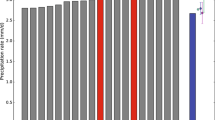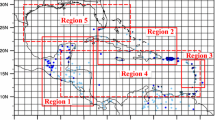Abstract.
A 5-year simulation of the atmospheric boundary layer in the CSIRO global climate model (GCM) is compared with detailed boundary-layer observations at six locations, two over the ocean and four over land. Field observations, in the form of surface fluxes and vertical profiles of wind, temperature and humidity, are generally available for each hour over periods of one month or more in a single year. GCM simulations are for specific months corresponding to the field observations, for each of five years. At three of the four land sites (two in Australia, one in south-eastern France), modelled rainfall was close to the observed climatological values, but was significantly in deficit at the fourth (Kansas, USA). Observed rainfall during the field expeditions was close to climatology at all four sites. At the Kansas site, modelled screen temperatures (T sc), diurnal temperature amplitude and sensible heat flux (H) were significantly higher than observed, with modelled evaporation (E) much lower. At the other three land sites, there is excellent correspondence between the diurnal amplitude and phase and absolute values of each variable (T sc, H, E). Mean monthly vertical profiles for specific times of the day show strong similarities: over land and ocean in vertical shape and absolute values of variables, and in the mixed-layer and nocturnal-inversion depths (over land) and the height of the elevated inversion or height of the cloud layer (over the sea). Of special interest is the presence climatologically of early morning humidity inversions related to dewfall and of nocturnal low-level jets; such features are found in the GCM simulations. The observed day-to-day variability in vertical structure is captured well in the model for most sites, including, over a whole month, the temperature range at all levels in the boundary layer, and the mix of shallow and deep mixed layers. Weaknesses or unrealistic structure include the following, (a) unrealistic model mixed-layer temperature profiles over land in clear skies, related to use of a simple local first-order turbulence closure, (b) a tendency to overpredict cloud liquid water near the surface.
Similar content being viewed by others
Author information
Authors and Affiliations
Additional information
Electronic Publication
Rights and permissions
About this article
Cite this article
Garratt, .J., Rotstayn, .L. & Krummel, .P. The atmospheric boundary layer in the CSIRO global climate model: simulations versus observations. Climate Dynamics 19, 397–415 (2002). https://doi.org/10.1007/s00382-002-0233-0
Received:
Accepted:
Issue Date:
DOI: https://doi.org/10.1007/s00382-002-0233-0




